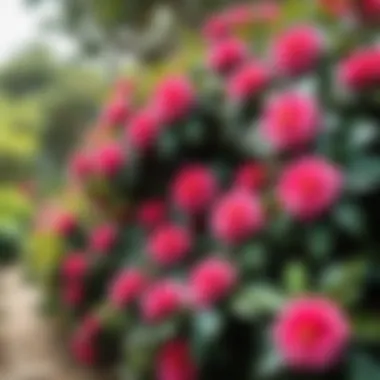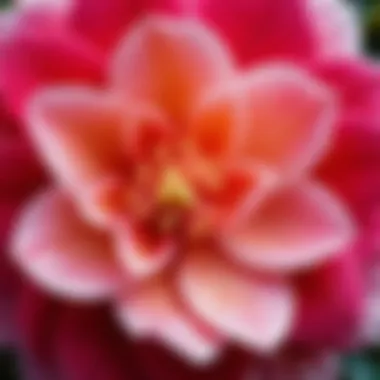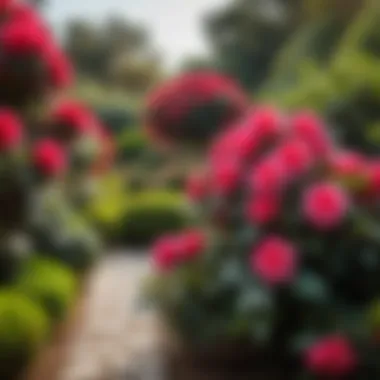Exploring the Intricacies of Camelia Gardens


Intro
Camelia gardens, often lesser-known than other flowering gardens, offer a unique blend of beauty and tranquility. Their intricate designs and vibrant blooms appeal to many, from gardening enthusiasts to casual visitors. This article seeks to unravel the various layers that make camelia gardens so special. We will explore their historical context, cultural implications, and practical advice for those looking to cultivate or visit these gardens.
Popular Destinations
Camelia gardens can be found across the world, each reflecting the local climate and culture. For travelers interested in garden design and nature, these destinations hold a treasure trove of discoveries.
- In Japan, the camelia holds a significant cultural place. Gardens such as the Koishikawa Korakuen offer scenic views and historical significance, where these blooms are celebrated in traditional tea ceremonies.
- In the United States, the Camellia Collection at the Huntington Library in California showcases thousands of varieties. This place draws in not just horticulturists but also people interested in American history and botanical art.
- Australia is known for its stunning coastal gardens featuring camellias, making it a perfect location for family vacations. Places like the Heritage Camellia Garden in Sydney highlight the adaptability of camellias in various environments.
Preparing for Your Journey
When planning a visit to camelia gardens, consider the following:
- Choose Your Route: Research the gardens you are most interested in. Some may require advanced booking or have specific visiting hours.
- Packing Essentials: Comfortable shoes are crucial as you will likely walk a lot. Also, bring a light jacket, as gardens can be cooler in the shade.
Visiting a camelia garden during bloom season can be a mesmerizing experience. Each flower tells a story of resilience and beauty.
- Photography Gear: If you enjoy photography, a good camera can capture the delicate beauty of camellias. Make sure to bring extra batteries and memory cards.
- Guided Tours: Some gardens offer guided tours, which can provide deeper insights about the flora and its historical context. This is beneficial for a richer experience.
In summary, camelia gardens provide not only a feast for the eyes but also a cultural journey. Whether you are a seasoned traveler or a newcomer, understanding these gardens enriches your visit.
The History of Camelia Gardens
Understanding the history of camelia gardens reveals much about the interplay between culture, ecology, and human innovation. This section examines how these gardens have evolved over time, showcasing their importance in various societies. Knowledge of their historical aspects not only enriches our appreciation but also encourages modern gardeners to integrate traditional techniques into contemporary designs. The legacy of camelia gardens is significant, fostering a connection between nature and human creativity.
Origins of the Camelia
Camellias are native to East Asia, specifically southeastern China, Japan, and Korea. The first recorded mention dates back to 1739 when botanist Charles Plumier named the plants in honor of Jesuit priest and botanist Georges Kamel. This history reflects their integration into various botanical and cultural pursuits.
The plant thrived in its native habitat due to the ideal climatic conditions. Varieties, such as Camellia japonica and Camellia sasanqua, gained popularity in garden design from the 18th century onward. With their glossy leaves and intricate blooms, they became a vital part of ornamental horticulture. Over time, the camelia spread across different regions, adapting to various climates and landscape designs.
Cultural Significance across Regions
Across the globe, camelia plants embody diverse meanings. In Japan, the camelia symbolizes devotion and is often used in traditional tea ceremonies, being intertwined with the country's cultural identity. The flower is a fixture in Japanese gardens, appreciated for its beauty and elegance.
In contrast, in the Western world, especially in the United States, camellias gained acclaim during the Victorian era. They were often featured in gardens of affluent individuals, highlighting status and aesthetic value. Additionally, camellias were introduced into Southern gardens, where they flourished in the warm climate. Their association with grace led to their depiction in various cultural expressions, enhancing their allure.
Camellias in Art and Literature
Camellias have found their way into art and literature, becoming symbols of various themes. They feature prominently in the works of notable artists like Édouard Manet and Claude Monet. Their delicate petals and vibrant colors rendered them as objects of study and admiration.
In literature, the camelia served as an emblem of love and beauty. Alexandre Dumas' novel, La Dame aux Camélias, presents the camelia as a poignant symbol of ephemeral beauty and social constraints. The narrative emphasizes the flower's role in social dynamics and romantic entanglements.
This connection between camellias and artistic expressions further solidifies their relevance in cultural narratives, inviting garden enthusiasts to explore their historical and artistic inspirations.
"The beauty of camellias is not only in their blooms but in their narratives woven through time and culture."
In summary, the history of camelia gardens is multifaceted, encompassing botany, culture, and artistry. Understanding the origins and significance of these plants provides a foundation for appreciating their role in contemporary garden design.
Ecological Importance of Camelia Gardens
Camelia gardens play a crucial role in promoting ecological balance. Beyond their aesthetic appeal, they contribute to regional biodiversity and support essential ecosystems. Understanding the ecological importance of these gardens is essential for garden enthusiasts and environmental advocates alike. They serve as a habitat for various creatures and enhance the local environment.
Biodiversity Contributions


Camelia gardens are more than just beautiful spaces. They have a significant impact on biodiversity. The diverse range of camellia species can support different types of wildlife. By planting a variety of camellia, gardeners can create microhabitats. These microhabitats attract various insects, birds, and small mammals, enriching local ecosystems. This biodiversity is critical as it helps to strengthen the resilience of the environment against pests and diseases. Moreover, camellias are often part of a larger ecosystem. They coexist with other plants, forming a balanced environment.
- Supporting Native Species: Camellias can provide food and shelter for native pollinators.
- Enhancing Genetic Diversity: The different varieties of camellias promote genetic diversity, which is essential for adaptation to changing conditions.
- Environmental Education: These gardens serve as educational sites, highlighting the importance of conservation and ecological stewardship.
Habitat for Pollinators
Another significant aspect of camelia gardens is their role as a habitat for pollinators. Pollinators are vital for the reproduction of many plants, including the camellia species. These gardens host various nectar-rich flowers that attract bees, butterflies, and birds. This abundance of resources supports the pollinator population, which is declining in many areas.
- Attracting Bees and Butterflies: Camellias bloom in different seasons. This ensures food availability for pollinators throughout the year.
- Creating Safe Spaces: The layered structure of camelia gardens provides shelter. These spaces protect pollinators from predators and harsh weather.
- Promoting Biodiversity: Healthy pollinator populations directly enhance biodiversity, allowing for a thriving ecosystem.
"Healthy gardens are a reflection of the health of their ecosystems. Camelia gardens exemplify this connection well."
In summary, camelia gardens serve pivotal ecological roles. They contribute to biodiversity, provide habitats for pollinators, and promote a balanced environment. For gardeners, understanding these contributions is vital. It informs their practices and reinforces the significance of creating sustainable gardens.
Designing a Camelia Garden
Designing a camelia garden requires careful thought and attention. The aesthetics of the garden are influenced not only by the choice of camelia varieties but also by the overall design and layout. A well-designed garden enhances the beauty of these flowering plants and allows gardeners to create a peaceful and retreat-like environment. It also promotes healthier growth and sustainability.
Selecting the Right Location
To achieve a flourishing camelia garden, selecting the right location is essential. Camelias thrive in slightly acidic soil, well-draining conditions, and partial shade to full sun. It is important to avoid spots where the plants may suffer from waterlogging. Consideration for the site’s climate is also critical; areas with afternoon shade tend to prevent leaf scorch, which is particularly crucial during the summer months. Observe how the sun moves across your yard to identify the best placement for your plants.
Choosing Camelia Varieties
The integrity of a camelia garden can be significantly enhanced by selecting the right varieties. Different species and hybrids can offer a range of colors, sizes, and flowering times. For instance, the Camellia japonica variety is known for its large, beautiful blooms, while Camellia sasanqua is more resilient to cold temperatures. Researching these varieties ensures that you not only enjoy the visual appeal but also adapt your garden to local growing conditions.
Creating Effective Layouts
Effective layouts can maximize the beauty and health of your camelia garden. The arrangement may follow a formal geometric pattern or an informal naturalistic style depending on personal preference. It is advisable to space camelias adequately to minimize competition for nutrients and moisture. Additionally, layering plants can improve visual interest. Taller camelias should be positioned towards the back of borders, while smaller varieties can be displayed in the front.
"The design of your camelia garden not only reflects personal taste but also dictates the growth and health of the plants within it."
Consider adding pathways, seating areas, or decorative elements to enhance the garden’s purpose. Keep in mind that seasonal changes will affect the garden’s appearance, so flexibility in design can ensure it remains appealing year-round.
Maintenance Practices
Maintaining a camellia garden is essential for ensuring vibrant blooms and the overall health of the plants. Proper maintenance practices not only enhance the aesthetic appeal of the garden but also ensure the longevity of the camellia species. Understanding how to effectively care for these plants can greatly impact their growth and flowering potential. Below, we explore key maintenance aspects: pruning, fertilization, and pest management.
Pruning Techniques for Health
Pruning is a critical maintenance practice that promotes healthy growth in camellias. It involves removing dead or diseased branches and thinning out crowded areas to improve air circulation. When done correctly, pruning can stimulate new growth and more abundant flowering.
- Timing: The best time to prune camellias is after blooming in late spring. This allows the plants to recover before the next blooming cycle.
- Tools: Use clean, sharp pruning shears to make clean cuts, reducing the chance of introducing disease.
- Technique: Aim for selective pruning, removing only about one-third of the plant. Focus on crossing branches, which can rub against each other and create wounds.
Careful and strategic pruning can lead to a more structured and vigorous plant, ultimately leading to a more impressive display.
Fertilization Guidelines
Fertilization is vital for providing the necessary nutrients that camellias need to thrive. A well-nourished plant will exhibit lush foliage and profuse flowers. Implementing the right fertilization strategy involves the following:
- Type of Fertilizer: Use a slow-release, acid-forming fertilizer, which is particularly suited for camellias. Products formulated for azaleas or rhododendrons also work well.
- Timing of Application: Fertilize in early spring just before new growth appears and again in late summer. Avoid fertilizing in late fall, as this can promote tender growth that may be damaged by winter chill.
- Application Rates: Follow the package instructions carefully to avoid over-fertilization, which can lead to nutrient burn.
Regularly feeding camellias optimizes their growth, encourages blooms, and ultimately sustains the beauty of the garden.
Pest and Disease Management
Effective pest and disease management is crucial for maintaining a healthy camellia garden. Various insects and diseases can threaten camellias, potentially diminishing their beauty and vigor.


- Common Pests: Watch for scale insects, aphids, and spider mites. Regular inspections enable early detection.
- Diseases: Camellias are susceptible to leaf blight and root rot. Maintain good air circulation and avoid water logging.
- Control Measures: Introduce beneficial insects such as ladybugs. Horticultural oils can also be effective against scales.
- Management: Remove affected leaves promptly and ensure proper drainage in planting areas.
Implementing a proactive approach towards pest and disease management fosters a resilient camellia garden.
“Regular maintenance is the foundation of a successful camellia garden.”
Seasonal Considerations
Understanding seasonal considerations in camelia gardening is essential for both the health of the plants and the overall aesthetic of the garden. Planting and caring for camellias requires different techniques and techniques depending on the season. This knowledge allows gardeners to maximize their efforts to achieve vibrant blooms and lush greenery throughout the year. By tending to seasonal needs, you will ensure that your garden remains beautiful and thriving.
Spring Blooming
Spring is a critical time for camellias as it is when many varieties begin to bloom. After a winter dormancy, the arrival of warmer temperatures prompts the plants to wake from their slumber. To prepare for the spring blooms, gardeners should focus on a few key areas:
- Pruning: Light pruning can be performed before the blooms appear, as it encourages bushier growth, enhancing the overall fullness of the camellias. Remove any dead or crossing branches to promote air circulation and sunlight penetration.
- Fertilization: Spring is the ideal time to fertilize camellias. A balanced, slow-release fertilizer can help support growth. Be mindful not to over-fertilize, as this can lead to excessive foliage growth at the expense of blooms.
- Watering Practices: Adequate watering is essential as the weather begins to warm and rainfall may become less frequent. Ensure consistent moisture but avoid waterlogging, which can harm the roots.
Spring is truly a delightful season for camellia gardens, as the colors begin to emerge, captivating attention.
Summer Care
During summer, the focus shifts towards maintaining the health and vigor of the camellia plants. The heat can pose threats, but with proper care, plants can thrive. Consider these points:
- Mulching: Applying a layer of organic mulch will help retain soil moisture and prevent weed growth. This is crucial during hot summer months when dryness increases.
- Watering Techniques: Routine deep watering is necessary. This encourages root growth. Watering early in the morning will help reduce evaporation and ensure the plants get the moisture needed for healthy growth.
- Pest Management: Keep an eye on possible pests such as aphids and spider mites. Regular checks can help catch any infestations before they spread. Use insecticidal soap if needed.
During summer, gardeners may also enjoy the lush, green foliage, even if the blooms have passed.
Autumn Preparation
As autumn approaches, preparation for the colder months becomes paramount. This phase sets the stage for winter survival. Pay attention to these aspects:
- Pruning: Late autumn is a fine time to perform more significant pruning. This is especially crucial for those camellias that may have suffered from summer heat.
- Pest and Disease Inspection: Before winter sets in, check for pests and diseases. Any issues should be addressed to prevent them from overwintering and affecting camellias come spring.
- Soil Care: Enriching the soil with compost or well-rotted manure can enhance its fertility. Healthy soil supports camellia growth and resilience.
Autumn is essential for setting camellias up for success during the harsh winter months. Taking proactive measures can help ensure that the plants come out strong in spring.
Camelia Gardens in Tourism
Camelia gardens play a pivotal role in tourism, intertwining natural beauty with cultural heritage. They serve as serene retreats that attract not just garden enthusiasts but also travelers looking for unique experiences. Incorporating camelia gardens into travel itineraries can enhance a destination's allure. Visitors get the chance to appreciate the rich biodiversity and exquisite aesthetics these gardens offer. Moreover, these gardens act as educational platforms, providing insights into local flora and horticulture.
Promoting Local Ecosystems
Camelia gardens are instrumental in promoting local ecosystems. This is achieved through several key aspects:
- Biodiversity Preservation: By nurturing camelia varieties, gardens contribute to conserving specific species that may be threatened or declining in their native habitats.
- Eco-Tourism Opportunities: These gardens foster eco-tourism by encouraging responsible travel practices that respect the environment and promote sustainability.
- Community Engagement: Local communities benefit economically through tourism related to camelia gardens. Engaging locals in garden maintenance or guided tours helps deepen the connection between tourism and community.
The interplay between tourism and ecology here enriches the experience for the tourists while ensuring that the natural habitat is preserved for future generations to enjoy.
Camellias as Tourist Attractions
Camellias, with their stunning flowers and diverse varieties, are significant tourist attractions in many regions. Their aesthetic appeal captures the interest of both amateur photographers and seasoned botanists alike. Notably, the following factors enhance their attractiveness:
- Seasonal Blooms: Many camelia varieties bloom during different seasons, offering visitors the chance to experience bursts of color throughout the year. This seasonal diversity can draw tourists in at various times.
- Special Events: Numerous gardens host festivals centered around camelia blooms. These events not only celebrate the flowers but also provide activities like workshops, guided tours, and local food tastings.
- Cultural Significance: In various cultures, camellias symbolize different virtues, such as love and loyalty. Gardens often highlight these stories, making visits more than just a visual pleasure but also a cultural learning experience.


Global Perspectives on Camelia Gardening
Understanding the global perspectives on camelia gardening is essential to comprehend how cultural, geographical, and environmental factors shape this discipline. Camellias, renowned for their stunning blossoms and rich foliage, are not exclusively a product of one region. They thrive in various climates and embody distinct interpretations across different cultures. This section aims to highlight how regional gardening traditions inform the cultivation and appreciation of camellias worldwide. Such insights assist gardeners and tourists to recognize the diversity and adaptability of these plants, enriching their gardening experiences and cultural knowledge.
Camellias in Asian Gardening
In Asia, particularly in countries like Japan and China, camellias have been cultivated for centuries, often deeply intertwined with local customs and aesthetics. Camellias, or Camellia japonica, for example, are not only a visual delight but also symbolize purity and admiration in Japanese culture. In Chinese traditions, the blooms represent perfection and good fortune. The art of bonsai also utilizes camellias, showcasing their versatility in various forms.
Asian gardeners often emphasize the importance of design principles, balancing natural forms with meticulous cultivation techniques.
- The layering of camellias in gardens promotes a sense of depth and biological diversity.
- Seasonal variations play a critical role in the gardening methodology, as each bloom cycle offers fresh opportunities for cultural expression.
- Traditional tea ceremonies often integrate camellias, emphasizing their multifaceted significance beyond just ornamentation.
These cultural practices not only highlight the aesthetic value of camellias but also encourage a harmonious connection with nature. As such, tourists interested in Asian gardens can expect not merely a visual feast but a comprehensive understanding of these plants’ roles within local cultures.
Western Interpretations
In contrast, Western gardening philosophies approach camellias from different angles, often focused on their ornamental value and landscape design. The introduction of camellias to Europe in the 18th century sparked a wave of interest that continues today.
Western gardeners tend to view camellias not only as beautiful flowering plants but also as part of broader landscaping strategies. Popular forms include:
- Formal hedges: Offering structure and symmetry in garden layouts.
- Mixed borders: Accompanying other seasonal plants that flourish during springtime.
- Container gardening: Making it easier to integrate camellias in smaller spaces.
Moreover, the designation of camellias as a focus in botanical gardens allows for a concentrated study and appreciation of their various species and hybrids. This engagement emphasizes the educational role of gardening within Western culture, fostering community interest and environmental stewardship.
Furthermore, both Western and Asian perspectives contain a significant appreciation for the sustainable practices involved in camellia gardening. These practices include natural pest management and organic fertilization, essential for maintaining healthy ecosystems.
"The study of camelia gardening across different cultures can reveal much about human relationships with nature, art, and community."
By recognizing and integrating these global perspectives on camelia gardening, both amateur and experienced gardeners can enrich their understanding and practice, turning their gardens into living testaments to nature’s beauty and individual cultural heritage.
Future Trends in Camelia Garden Design
The design of camelia gardens is evolving in response to environmental challenges and advancements in technology. Understanding these trends is essential for gardeners and architects, as they create spaces that not only showcase beauty but also embrace sustainability and innovation. This section will examine specific elements of future trends, including sustainability practices and the integration of technology, emphasizing their benefits and considerations.
Sustainability Practices
Sustainability in garden design is no longer optional; it is a necessity. Gardeners are increasingly focusing on creating environments that minimize harm to the ecosystem while maximizing enjoyment for visitors.
- Native Plant Selection: Choosing camelia varieties that are native to the local area promotes biodiversity. Native plants are adapted to local conditions, requiring less water and maintenance. This practice supports local pollinators and enhances ecological balance.
- Water Management: Implementing rain gardens or using permeable materials can help manage water runoff. Techniques like drip irrigation and rainwater harvesting are becoming popular. These methods conserve water and ensure that the plants receive the adequate hydration they need.
- Soil Health: Focusing on soil biodiversity is critical. Adding organic compost not only enriches the soil with nutrients but also improves its structure. Healthy soil contributes to stronger plants and better resistance to diseases.
Adopting these sustainable practices reduces the carbon footprint and creates resilient gardens that thrive in changing climates. Visitors can appreciate a camelia garden that not only looks good but also contributes positively to the environment.
Integrating Technology
As technology continues to advance, its application in gardening becomes more prevalent. Integrating technology into camelia garden design presents exciting possibilities.
- Smart Irrigation Systems: These systems adjust water flow based on weather conditions and moisture levels in the soil. Water conservation is vital, especially in areas facing drought or water scarcity.
- Garden Management Apps: Gardeners can utilize various apps to track plant health, schedule maintenance tasks, and even receive pest alerts. Such tools help amateurs and professionals alike manage gardens more effectively.
- Drone Technology: Drones can be used for aerial surveys to assess garden layouts and health. This capability allows for efficient planning and monitoring of larger gardens.
Technology enhances the gardening experience, providing tools that make it easier to maintain healthy and sustainable camelia gardens.
In summary, the future of camelia gardens lies in their adaptability to sustainable practices and technological advancements. By embracing these trends, gardeners support ecological health while also engaging a modern audience looking for innovative solutions in garden design.
The End
The conclusion of this article aims to synthesize the insights shared throughout the exploration of camelia gardens. Understanding the essence of camelia gardening is important not just for aesthetic enjoyment, but it also serves deeper purposes related to ecology and culture.
Summary of Key Insights
In summary, camelia gardens offer more than just visual appeal. They play a vital role in promoting biodiversity and supporting local ecosystems. By diving into the history of camelia, we see its cultural significance across regions and its inspiring presence in art and literature. The practical aspects discussed, such as maintenance practices and seasonal considerations, provide useful guidelines for both novice and experienced gardeners. The exploration of these gardens highlights the harmonious relationship between nature and human creativity.
Call to Action for Gardeners and Tourists
For gardeners, the insights gained should inspire action. Creating a camelia garden could be rewarding, both personally and ecologically. Those interested in tourism should seek out camelia gardens when traveling, as they offer unique experiences that enhance appreciation for nature. Engage with local gardening communities and consider participating in workshops or tours. This engagement not only enriches personal knowledge, but also fosters a connection to the natural world, encouraging sustainable practices that benefit both gardens and visitors.







